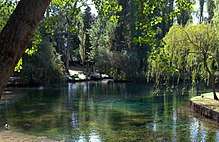Clitunno
The Clitunno, in Antiquity the Clitumnus, is a river in Umbria, Italy. The name is of uncertain origin, but it was also borne by the river god. The Clitunno rises at 42°49.5′N 12°46′E from a spring within a dozen metres of the ancient Via Flaminia near the town of Campello sul Clitunno between Spoleto and Trevi: the spring was celebrated as a great beauty spot by the Romans but also by Byron and Giosuè Carducci; in the 19th century it was planted with willows, and zealously monitored for pollution, it is open today as a paying tourist attraction.
| Clitunno | |
|---|---|
 Source of the Clitunno near Campello sul Clitunno | |
| Location | |
| Country | Umbria, Italy |
| Physical characteristics | |
| Mouth | Timia |
⁃ location | Bevagna |
⁃ coordinates | 42.9329°N 12.6042°E |
| Basin features | |
| Progression | Timia→ Topino→ Chiascio→ Tiber→ Tyrrhenian Sea |

The Clitunno then flows, generally north, through the east Umbrian plain, past the Temple of Clitumnus and the towns of Pissignano, Cannaiola and Trevi, to join the Timia, a tributary of the Topino, near Bevagna.[1] Though its current is usually sluggish, it is subject, like many other rivers in the east Umbrian plain, to sudden flooding: it was only tamed completely in the 19th century, and is largely banked by levees.
References
- Agenzia regionale di protezione ambientale dell'Umbria, Caratterizzazione dei bacini idrografici e dei corpi idrici superficiali, Sottobacino Topino Marroggia, map p. 10 of 22.
External links
![]()
